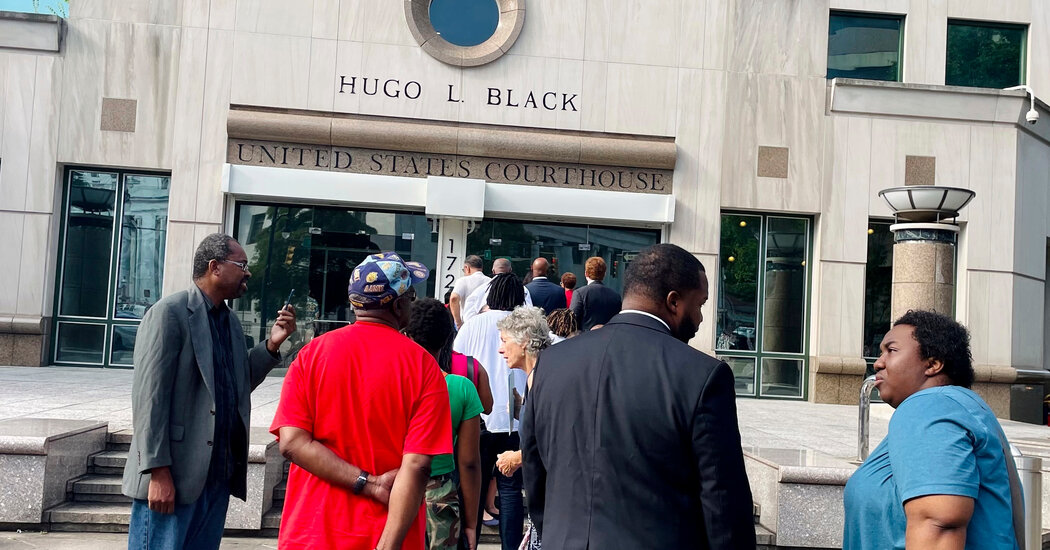
 News
News 
A federal court ordered Alabama on Thursday to use a new congressional map that could lead the state to elect two Black representatives for the first time in its history, by creating a second district with close to a majority of Black voters.
The order, the culmination of a nearly two-year fight over the Republican-dominated state’s illegal dilution of Black voting power, could also see Democrats pick up a seat in the state, at a moment when Republicans control the House of Representatives by a thin margin.
A three-judge panel of the U.S. District Court for the Northern District of Alabama approved a map that increases the percentage of Black voters in one of the state’s six majority-white congressional districts to 48.7 percent, up from about 30 percent, while preserving the state’s one existing majority-Black district.
“This is an unequivocal win that will translate to increased opportunities for those who have too long been denied the fair representation they deserve,” the group of Black voters who brought the case said in a joint statement released by the NAACP Legal Defense and Educational Fund, which has helped the voters sue the state. “Though a long, hard-fought battle, we are grateful to have achieved this key measure and look forward to building a better future for Alabama voters,” the statement said.
Alabama, a state with a fraught history of bucking federal voting rights and civil rights laws until the courts intervene, resisted creating a second district with enough Black voters to allow them to elect a representative of their choice. The state’s only such district, held by Representative Terri Sewell, a Democrat, was created in 1992 after a lawsuit.
More than one in four residents of Alabama are Black, but six of the state’s seven seats in the House of Representatives have been held for more than a decade by white Republicans. Because of how racially polarized voting is in the state, Black voters tend to support Democratic candidates.
The state’s defiance of calls for fairer district maps led the Supreme Court to weigh in twice this year, both times siding with a lower court’s ruling that Alabama had violated a landmark voting rights law by undercutting the power of Black voters in the state.
Wes Allen, Alabama’s secretary of state, said his office would use the new map that the court had “forced upon Alabama” for the 2024 election cycle, though he signaled that the state would continue its appeals in the case.
Steve Marshall, the Alabama attorney general, charged that the map “violates the Constitution’s guarantee of equality for all” and vowed to “defend the state’s law in court for future elections.”
After the Republican-controlled Alabama Legislature redrew the state’s district map following the 2020 census, several Black voters sued in federal court to challenge the legislature’s map. Though the trial court agreed with the plaintiffs that the map violated the Voting Rights Act of 1965, the Supreme Court allowed it to be used for the 2022 elections, saying there was not enough time to change the district boundaries for that election.
In June, however, the Supreme Court stunned many observers by upholding the main remaining tenet of the Voting Rights Act and agreeing that the legislature’s map was in violation. That ruling has reverberated across the South, where several states are confronting similar challenges, and forced the Alabama Legislature to draw a new map.
But Republicans, loath to pit two of their own incumbents against each other, came up with a proposed map that the trial court said still fell short of its mandate to create a second majority-Black district or something close to it. In a sharp rejection last month, the court turned instead to a special master, Richard Allen, a longtime Alabama lawyer, to oversee the creation of a new map without the legislature’s involvement.
The court’s decision was joined by Judges Anna M. Manasco and Terry F. Moorer, both named to the bench by former President Donald J. Trump, and Judge Stanley Marcus, a Clinton nominee.
Mr. Allen, aided by David Ely, a demographer, put forward three separate proposals last month for the court to choose among.
The court opted for the map that it said did the best job of fulfilling its order without upending too many of the existing districts. The new map reduces the percentage of Black voters in Ms. Sewell’s district, the Seventh, to about 52 percent and increases the share of Black voters in the neighboring Second District.
“Black people in the Black Belt will actually now have a significant level of representation that they wouldn’t have had before, particularly in the eastern part of the state,” said Kareem Crayton, the senior director for voting and representation at the Brennan Center for Justice. “The southeastern part of the state has always been kind of divvied up in ways that has sort of impeded representation, particularly for Black-preferred candidates.”
“Now, really for the first time, you’ll see what that looks like,” he said.
Officials in Alabama must now grapple with the political consequences, particularly since two Republican incumbents, Barry Moore and Jerry Carl, will now be residents of the same district, the First.
Mr. Carl, a member of the powerful House Appropriations Committee and less of a conservative firebrand than Mr. Moore, said on Thursday that he still plans to run for re-election in the First District.
24World Media does not take any responsibility of the information you see on this page. The content this page contains is from independent third-party content provider. If you have any concerns regarding the content, please free to write us here: contact@24worldmedia.com